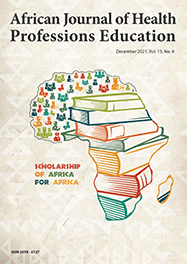Articles

Problem-solving abilities of radiography students at a South African university
Abstract
Background. Developing the problem-solving skills of student radiographers is imperative for encouraging critical thinking and allowing them to work efficiently in an era of rapidly advancing technology. Students’ ability to demonstrate these skills was studied so that the Department of Radiography, at a comprehensive university in South Africa, could develop a more explicit curriculum to facilitate these competencies.
Objective. To assess problem-solving skills of third-year radiography students at a comprehensive South African university.
Methods. The study employed a descriptive exploratory design. The participants’ responses to vignettes (in the form of clinical scenarios) were analysed using a Likert scale and action verbs developed for evaluating evidence of problem-solving skills and providing quantitative data. Field notes were made while analysing responses to each question, providing qualitative data.
Results. The findings indicate that the majority of participants demonstrated a minimal ability to problem solve in a vignette. This implies that to improve problem-solving skills of student radiographers, there is a need for curriculum adjustment to nurture and encourage this competency.
Conclusion. Facilitators need to be taught methods to integrate problem solving into the curriculum, and learning material must be adjusted to accommodate problem solving for this skill to become part of the programme outcomes.
Authors' affiliations
Tracey Dawn Pieterse, Department of Radiography, University of Johannesburg, South Africa
Heather Lawrence, Department of Radiography, University of Johannesburg, South Africa
Hesta Friedrich-Nel, Central University of Technology, Bloemfontein, South Africa
Keywords
Cite this article
Article History
Date published: 2014-03-11
Article Views
Full text views: 10416




.jpg)
Comments on this article
*Read our policy for posting comments here